Concerned parents seek reassurance from Red Cross radiation scans in Fukushima City
2012/05/22
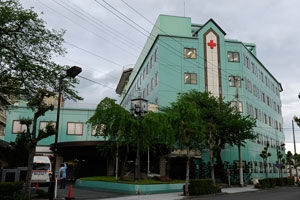
Inside the big green bulk of the Red Cross Hospital in Fukushima City, Yukie Kanno is seeking reassurance as her five-year-old daughter, Nanami, is scanned for radiation – first with a geiger counter to measure the radiation level of the surface in preparation for a whole body scan to measure potential internal radiation exposure.
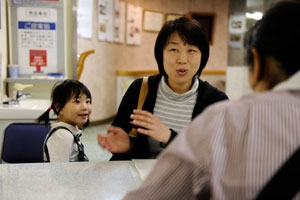
Class shrinks
Last year the number of girls in Nanami’s class shrank from 12 or 13 to only 5 when school resumed in September after the summer vacation. “Nanami looked sad.”
“We used to buy local products (vegetables, etc.) at farm stalls, but now I only buy those from outside Fukushima prefecture.
Ms. Kanno says: “My parents grow vegetables in their own garden, and the radiation check results show negative. But still we don’t eat them and my parents have stopped giving them to us.”
(Photo: Ms. Yukie Kanno and her 5-year-old daughter, Nanami)
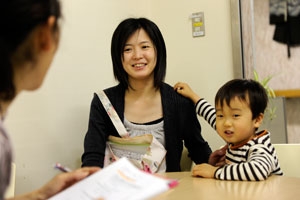
Caution can take toll
But she realizes that caution over radiation can also take its toll on general health. “My oldest daughter is in the 3rd grade in primary school, and it takes about 40 minutes to walk from home to her school. Last year I gave her a ride in the car every day, but from this January, I let her walk unless it is raining because she started to gain weight.”
Fellow mother Mizuko Tanaka seems to have similar concerns for her little boy, Yuuta, 4. “I try not to set up any restrictions for my child’s daily life. I let my child play outside when we have a break because I am rather concerned about the possible deterioration in physical strength that can be brought about by regulating children’s behavior too much.”
(Photo: Ms. Mizuko Tanaka and her 4-year-old son, Yuuta)
Among the other parents who have brought their children for the body scan is Tomonori Takeuchi with his 4-year-old daughter Yuua.
“I myself am not concerned about the impact of the radiation, but my wife is, and she wants to have Yuua checked in whatever way is possible. “ Mrs. Takeuchi and Yuua have in fact left Fukushima and moved to Yamagata prefecture, further to the north, so her husband has brought the child specially to be tested.
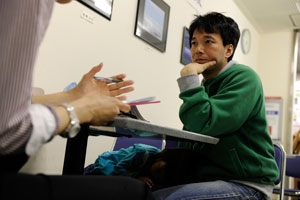
Yet to decide
He says they have yet to decide where to base themselves permanently, but he has concerns of a different kind, stemming from the lingering prejudice that many people say is directed in other parts of Japan towards survivors of the nuclear accident.
“Given that my child is a girl, I am not sure if it is okay to bring her up in Fukushima, because she will be labeled as a ‘Fukushima grown girl’ in the future,” he says. Apparently behind this comment is a worry about the kind of discrimination faced decades ago by Hiroshima and Nagasaki survivors, who were widely thought by people from other parts of Japan to have been rendered infertile by radiation exposure – which proved in many cases to be totally false.
(Mr. Tomonori Takeuchi shows his concern about the health impact of radiation on his 4-year-old daughter, Yuua.)
The scan results will take about four weeks to deliver to the families. The result sheet shows whether or not internally exposed level of radiation is over 1 mSv, health authorities’ benchmark level.
But technicians say that since the whole body scanners were installed a few weeks ago, so far there have been no cases of radiation exposure exceeding 1 mSv.
-
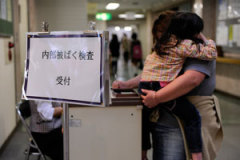
Registration desk for body scan examination (c)Nobuyuki Kobayashi
-
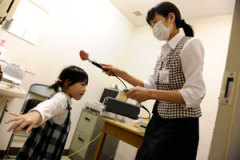
A five year old girl being scanned for radiation adhering to her clothes, using a geiger counter. The next step is a whole body scan, using equipment provided by Japanese Red Cross Society. (c)Noboyuki Kobayashi
-
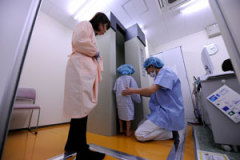
A child is helped into the whole body scanner in Fukushima Red Cross Hospital.(c) Noboyuki Kobayashi
-
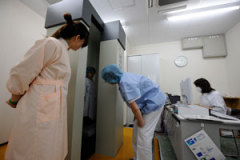
The person being scanned needs to stand absolutely still inside the machine for two minutes, which is not easy for a small child. (c)Nobuyuki Kobayashi















